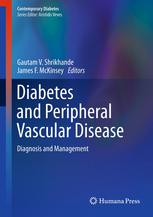

Most ebook files are in PDF format, so you can easily read them using various software such as Foxit Reader or directly on the Google Chrome browser.
Some ebook files are released by publishers in other formats such as .awz, .mobi, .epub, .fb2, etc. You may need to install specific software to read these formats on mobile/PC, such as Calibre.
Please read the tutorial at this link: https://ebookbell.com/faq
We offer FREE conversion to the popular formats you request; however, this may take some time. Therefore, right after payment, please email us, and we will try to provide the service as quickly as possible.
For some exceptional file formats or broken links (if any), please refrain from opening any disputes. Instead, email us first, and we will try to assist within a maximum of 6 hours.
EbookBell Team

4.1
100 reviewsIn Diabetes and Peripheral Vascular Disease, a panel of distinguished leaders in the field of medicine, podiatry, and vascular and endovascular therapy assimilate the latest literature on these issues and others for an in-depth review of the management of peripheral vascular disease. Providing an overview of the management of diabetes and diabetic foot changes as well as providing a view of cutting-edge and emerging topics in optimization of arterial status, this important title addresses pathophysiology, anatomy, diagnosis and management of diabetic peripheral vascular disease, emphasizing a multi-disciplinary approach. The first chapter of the book provides an overview of this complex disease process and discusses the teamwork required for optimal management. The chapters continue with the basic pathophysiology of diabetic atherosclerosis and a contemporary review of the management of diabetes. The genesis of diabetic foot ulceration and prevention and management strategies is covered, as is the effects of neuropathy and microvascular changes in the diabetic foot. In addition, Diabetes and Peripheral Vascular Disease covers the microbiology of diabetic foot infections, the role of endovascular interventions and vascular surgery as well as the management of the complications of these procedures, the process of amputation for those patients who have progressed beyond a limb salvage situation, and the effects of diabetes on the cerebrovascular system as well as its implications in patients with aortoiliac disease. An invaluable addition to the literature on diabetes and peripheral vascular disease, the book will be of great interest internists, family practitioners, surgeons, podiatrists, wound care specialists, and vascular specialists. Students, residents, and fellows in surgical and medical specialties should also find this book of significant value and interest.